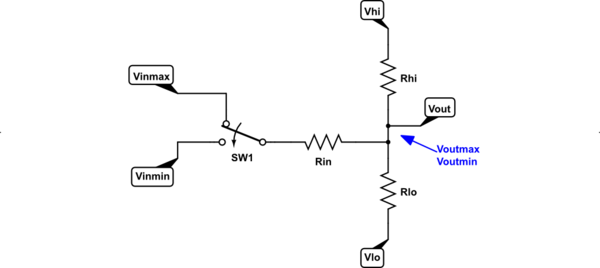Spehro's comment elsewhere here (to M.Ferru) about symmetry (the two input voltages and output voltages are arranged symmetrically) provides a very large and obvious simplification -- that it must be the case that \$R_1=R_2\$. This immediately tells the values for those two, given your other input to the problem (\$R_1+R_2=10\:\textrm{k}\Omega\$.) From there it should only take you a moment or two to work out the value of \$R_3\$.
But I want to provide a less directly useful, but far more general approach in order to make Spehro's point all the clearer to you by showing what happens if you don't take advantage of symmetries you find (or if they don't exist.) It also shows how a simple three-resistor problem can bloom, algebraically.
Let's look at this in its most general form:

simulate this circuit – Schematic created using CircuitLab
There are two equations in play:
$$\begin{align*}
V_{OUT_{MAX}}&=\tfrac{V_{IN_{MAX}}\cdot R_{HI}\cdot R_{LO}+V_{LO}\cdot R_{HI}\cdot R_{IN}+V_{HI}\cdot R_{LO}\cdot R_{IN}}{R_{HI}\cdot R_{LO}+R_{HI}\cdot R_{IN}+R_{LO}\cdot R_{IN}}\\\\
V_{OUT_{MIN}}&=\tfrac{V_{IN_{MIN}}\cdot R_{HI}\cdot R_{LO}+V_{LO}\cdot R_{HI}\cdot R_{IN}+V_{HI}\cdot R_{LO}\cdot R_{IN}}{R_{HI}\cdot R_{LO}+R_{HI}\cdot R_{IN}+R_{LO}\cdot R_{IN}}
\end{align*}$$
And this solves out as:
$$\begin{align*}
\tfrac{R_{HI}}{R_{LO}}&=\tfrac{V_{HI}\cdot\left(V_{IN_{MAX}}-V_{IN_{MIN}}\right) + V_{OUT_{MAX}}\cdot\left(V_{IN_{MIN}}-V_{HI}\right)-V_{OUT_{MIN}}\cdot\left(V_{IN_{MAX}}-V_{HI}\right)}{V_{OUT_{MIN}}\cdot\left(V_{IN_{MAX}}-V_{LO}\right)-V_{LO}\cdot\left(V_{IN_{MAX}}-V_{IN_{MIN}}\right) - V_{OUT_{MAX}}\cdot\left(V_{IN_{MIN}}-V_{LO}\right)}\\\\
\tfrac{R_{IN}}{R_{LO}}&=\tfrac{V_{HI}\cdot\left(V_{IN_{MAX}}-V_{IN_{MIN}}\right) + V_{OUT_{MAX}}\cdot\left(V_{IN_{MIN}}-V_{HI}\right)-V_{OUT_{MIN}}\cdot\left(V_{IN_{MAX}}-V_{HI}\right)}{\left(V_{HI} - V_{LO}\right)\cdot\left(V_{OUT_{MAX}} - V_{OUT_{MIN}}\right)}
\end{align*}$$
Plugging in your values:
$$\begin{align*}
V_{OUT_{MIN}}&=4\:\textrm{V}\\\\
V_{OUT_{MAX}}&=6\:\textrm{V}\\\\
V_{LO}=V_{IN_{MIN}}&=0\:\textrm{V}\\\\\
V_{HI}=V_{IN_{MAX}}&=10\:\textrm{V}
\end{align*}$$
You get:
$$\begin{align*}
\frac{R_{HI}}{R_{LO}}&=1&\therefore R_{HI}= R_{LO}\\\\
\frac{R_{IN}}{R_{LO}}&=2&\therefore R_{IN}= 2\cdot R_{LO}
\end{align*}$$
Note that all this work has led to the same point that Spehro made, right away: that \$R_1=R_2\$. You need to develop an eye for these symmetries.


